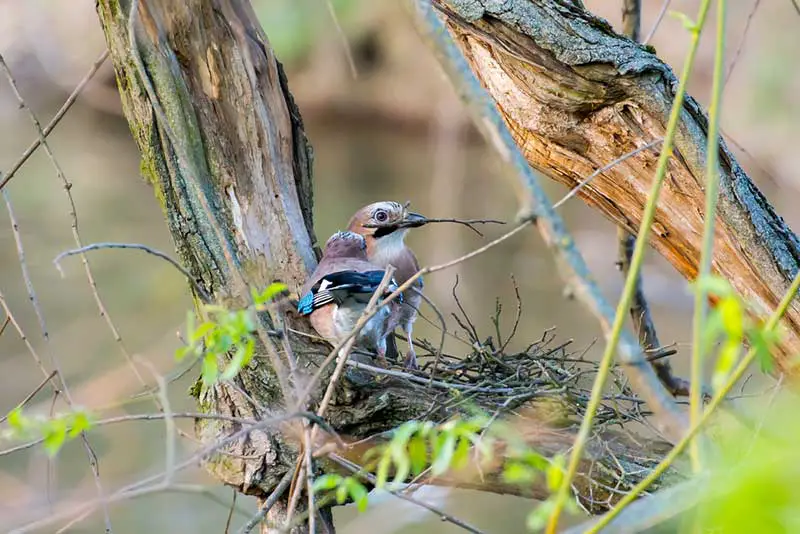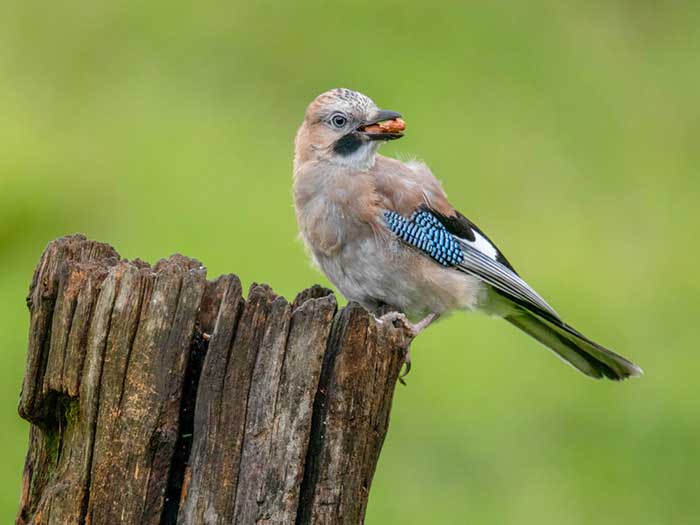I have a new-found fascination with the jay. It began when I found out that their passion for acorns is credited with the rapid spread and regrowth of oak trees after they were wiped out in the last Ice Age.
Their hidden cache of food, stored for winter when acorns aren’t prevalent, is often forgotten, leaving it to germinate and into the sprawling oak trees that we recognise.
I don’t have an oak in my garden, so I wonder, where do jays nest and am I likely to see them raise?
Jays are common almost everywhere in the UK; only the far north of Scotland isn’t graced with their presence.
They build their nests, rather scruffy affairs, high up in trees and bushes, most often in parks and woodland, and occasionally in mature gardens.

Table of Contents
Do jays build their nests in a particular tree?
Jays aren’t too particular in which tree they construct their nests; however, they prefer woodland with an abundance of oak trees.
They choose coniferous and deciduous trees, shrubs in scrub and parkland, also urban areas. You’re most likely to find jay’s nest in dense woodland with heavy foliage; they’re shy and prefer to hide away from view.
They prefer broadleaf trees as they supply most cover.
About jay’s nests
Jays choose a spot close to the trunk or in a fork of the tree, probably for added stability. They prefer to be well-hidden so choose mature trees with plenty of foliage.
Their nests are always higher than 2-metres above the ground.
Both the male and female jay contribute to nest building. They are industrious birds that happily travel great distances to find the best twigs on live trees. This is somewhat strange as they seem to build their nests in a very haphazard manner – they are scruffy.
Live twigs are less brittle than dead ones; they are more malleable to bend into a cup-like shape. The birds also use sturdy plant stems and apply mud to act as the cement to hold everything together.
When it comes time to make the inner cup, jays are much more fastidious. They intricately weave together fine plant material and hair to prepare a soft lining for their chicks.
Rootlets are a favoured lining material; they fly several miles looking for freshly dug ditches and graves to collect the best roots they can find.
The contrast between the inside and outside of the nest is amazing. Perhaps they feel predators are less likely to approach a tatty nest, thinking it is already abandoned.

When do jays build their nests?
They begin work on their nests in April in readiness for their solitary brood.
Female jays lay 4-5 glossy, speckled eggs in shades of pastel blue and green. The nest needs to be sturdy as she incubates them for 16 days; chicks don’t begin to fledge until at least 22-days later, even then returning to the nest for a few more days for food.
If a jays nest is disturbed by predators, the adult birds abandon it and never return. Luckily this doesn’t happen too often as they’re well hidden, and the warning screech of the jay terrifies even the most ferocious cats!
How do jays choose a mate?
Finding a mate is a pretty intense affair if you’re a jay; it should be as they usually mate for life.
Groups of jays gather in a woodland opening called a Crow Marriage.
Some of the birds perform a dance or a series of movements to try and prove their worthiness of the strongest mate, both males and females exhibit this behaviour.
When a match is agreed the birds instantly set about finding a territory to protect and build their nest.
Although the birds remain mated for life, they live fairly solitary lives; only meeting up in a breeding season or when their nest and territory need to be protected.
Final thoughts
Jays are intelligent birds that sensibly choose where to nest to offer their chicks the greatest survival chances.
If their well-hidden nests are discovered, the loudmouth birds use their call, or their ability to mimic other larger birds to warn the predator away. A bit cheeky really when you consider they happily raid other nests to feed on eggs and the young of smaller birds.
I like jays; they’re impressive birds, clever, easy to recognise, and fiercely protective of their family.

Nice article. I have a family of Blue Jays that have been here for several years. I make sure I always have peanuts in the feeders as they can’t seem to resist them. I really liked adding your bird facts to my mental library. So thank you. You did a great job.
Every year at this time the jays come to our aged lilac tree for twigs. Just lilac as far as we know. They a picky, so they leave a mess of twigs on the patio!
Pondering – why do the jays feed on our poor looking nispro fruits (in Spain) rather than next door’s perfect looking fruits? Perhaps it’s because ours has more foliage and they can hide. Your article was a brilliant read and made us feel pleased that we’d come up with the right answer. The y have been removing the stones from the flesh in much the same way that a song thrush deals with snails; a large brick has become their ‘anvil’.
We put whole monkey nuts out for our Jays. We have had them come indoors to raid the bag of nuts in the summer months which was thrilling. Even when the bag has been moved they recognised it and helped themselves. I was just glad i could help them